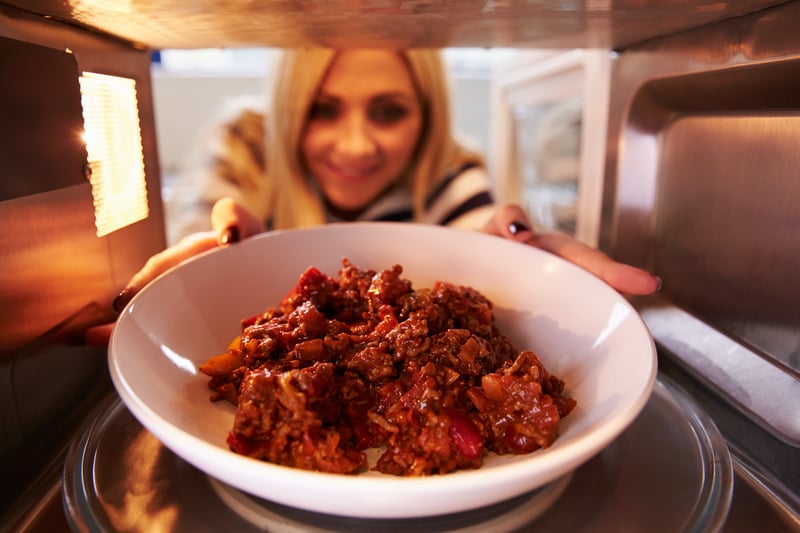How to Reheat These 6 Tricky Leftover Meals

Whether dinner tonight is planned leftovers, food that’s been prepped, or you’re just reheating last night’s dinner for lunch, knowing how to reheat leftovers safely will help reduce food waste, keep your belly and tastebuds satisfied, and save money.
Foods that aren’t reheated (or refrigerated) properly, on the other hand, can lead to upset stomachs and worse. According to the CDC, one in six Americans experience food poisoning, and around 128,000 people are hospitalized each year. So, this knowledge doesn’t just prevent discomfort, it can help keep you safe.
Plus, knowing how to properly reheat leftovers can make the food much more appealing to eat!
In today’s article about how to reheat leftovers, we will cover:
- How to Reheat Eggs
- How to Reheat Grains
- How to Reheat Baked, Fried and Roasted Foods
- How to Reheat Pizza
- How to Reheat Pasta
- How to Reheat Shrimp
How to Reheat Leftovers in General
Start by removing the food from the heat and, if there’s a larger quantity, transfer it to a shallow dish to help the heat dissipate more quickly. If it’s a softer food like soup or stew, give it a quick stir occasionally as it cools.
Now it’s time to ensure the food is properly refrigerated. Any food that’s been left out for more than two hours (one hour if it’s over 90 degrees F) or, after refrigerated, not eaten within three or four days should be tossed as it can grow bacteria and other organisms that can lead to foodborne illness.
If you can’t eat the food right away, you can place it in the freezer to store for up to four months. (It can still be safe to eat after that, but texture and flavor may be negatively affected.)
Once it’s time to reheat, to save time, you can defrost or partially defrost it in the refrigerator for up to 24 hours before heating fully in a saucepan, oven, or microwave. Before reheating, it’s best to defrost. Otherwise, many foods can get watery or dry out too much during the reheating process.
To protect the food, you’ll want to reheat it only once—so only heat as much food as you’ll be eating. If you still have leftovers, leave them in the fridge or freezer. And avoid refreezing food once it’s been defrosted. This is also to prevent food poisoning as the risk increases with every reheating.
When it’s time to eat, reheat the leftovers until they’re hot—not warm—around 165 F or 70 C for at least 2 minutes. Stir regularly if possible, so they reheat evenly, especially when heating them in a microwave.
Some tricky leftovers need additional instructions to ensure the food is still safe to eat and tastes good.
LIMITED TIME OFFER: Get Ageless Turmeric, Our Highly-Bioavailable Turmeric & Ginger Supplement, As Low As $14
How to Reheat Leftovers in the Oven
The oven is one of the best ways to reheat leftovers. Sure, it can take a bit longer than the microwave, but the foods are more likely to retain their taste and texture. The oven is especially good for helping vegetables stay crisp, maintaining the consistency of casseroles, and for meats to avoid becoming dry, rubbery, and unappetizing.
Reheat using a lower temperature than you used to cook the food originally—around 200 to 250 degrees F. For meats, it can also help to add a touch of oil or butter to help prevent them from drying out.
Foods that reheat well in the oven (or toaster oven) include:
- Breads
- Breaded foods
- Baked goods
- Roasted or grilled meats
- Grilled sandwiches
How to Reheat Leftovers on the Stove
The stovetop is the best way to reheat stews and soups as well as slow-cooker, stir fry, and skillet meals. The stovetop can, of course, also be used to reheat meat or chicken as well.
To help preserve the taste and texture, don’t be in a hurry. Instead, reheat the foods over low heat, stirring regularly if possible.
Again, with meats, adding a bit of oil or butter helps keep the moisture in, as does covering with a lid as it reheats. It should take only about five minutes per side to reheat through.
A stovetop is a great option for helping many foods retain their original texture. Examples include:
- Soups
- Stews
- Chilis
- Rice
- Noodles
- Sautés
- Stir-fries
- Meat
If you’re reheating a delicate sauce or mashed potatoes, use a double boiler, so the food isn’t over direct heat, which can cause it to scorch or separate.
How to Reheat Leftovers in the Microwave
While microwaving is the most convenient and quickest way to reheat, and it does help retain nutrients in foods, it rarely results in the best taste or texture. The microwave can be used, but it’s probably the last choice.
One of the biggest challenges with microwaves is that the food is boiling hot on the outside yet still cool or even cold on the inside. If you’re reheating a slice of quiche, a serving of lasagna, enchiladas, or any casserole, cut it into pieces or chunks before heating. This will allow the food to cook more quickly and more evenly.
What about red meat or poultry? Both can get dry and rubbery quickly. So, to help them stay moist, sprinkle some water over the meat before cooking it with a microwave-safe lid. And avoid overcooking it, which just makes it inedible.
Microwaves are surefire timesavers, so knowing the best foods to reheat with this method, without altering the texture, is useful. Generally, these types of foods survive fairly well:
- Soups
- Stews
- Sautés and stir-fries
- Steamed or boiled veggies
- Casseroles
How to Reheat These Tricky Leftovers
1. How to Reheat Eggs
The best advice is to not, especially if they’re fried, poached, or scrambled. Quiche or other baked eggs, however, can be revived. For best results, place into a preheated oven (365 degrees F) and cook for about 15 minutes.
You can also reheat them on the stovetop. Start by adding a dab of oil or butter to a saucepan, and once melted, add your eggs, top with a lid, opening just to stir if needed.
If you are microwaving an egg muffin and it’s a little dry, add a teaspoon of your preferred milk, so it doesn’t dry out more. Then microwave on high for just 20 to 25 seconds. Hardboiled or deviled eggs are, of course, best enjoyed cold.
2. How to Reheat Grains
Grains like rice, barley, and (grain-like) quinoa or amaranth can be tricky as they often get dry and crunchy. Fortunately, it’s easy to solve this problem by adding a splash of water to allow them to soften as they reheat. You can also combine the grains with the other leftovers to reheat together. This works especially well if you have a sauce or gravy.
3. How to Reheat Fried or Baked Foods
If you’ve ever tried to reheat baked, fried, or roasted foods in the microwave (e.g., French fries), you likely immediately regretted the decision. Is there any way to revive these tricky foods without ending up with a soggy, unappetizing mess?
First, skip the microwave and head toward the oven instead. For roasted vegetables, including greens like Brussel sprouts and root vegetables like sweet potatoes, lay them out on a baking sheet in a single layer and stick them under a preheated broiler. Within one to three minutes per side, you’ll enjoy a nice, crispy dish again. There’s no need to add oil, water, or anything else.
A toaster oven works just as well and uses less energy. It may, however, take a bit longer—5 to 10 minutes at about 350 degrees.
4. How to Reheat Pizza
Many people love a slice of cold pizza, but if you want to revive pizza back to its previous glory, please avoid the microwave. Instead, pop it into an air fryer for about 8 to 10 minutes (or according to your air fryer’s recommendations), which reheats without resulting in a soggy, greasy mess.
No air fryer? You can also place a slice on a sheet tray and put it in a preheated oven (425-degree F) for 4 or 5 minutes. A toaster oven works well for a single slice.
5. How to Reheat Pasta
If you aren’t careful, pasta can quickly turn into a gummy, sticky clump. Again, avoid the microwave and head toward the stovetop instead. Place the cold pasta in a saucepan over medium heat. Allow it to start to warm and then add a splash of water gradually as you stir. (You may need to continue adding splashes, but don’t add too much.) Be careful to avoid over reheating, which can make pasta fall apart.
6. How to Reheat Shrimp
Shrimp is a tricky one as it tends to turn rubbery or almost spongy when reheated. Again, the key is to skip the microwave and instead reheat shrimp by either putting it in the oven or sautéing on a stovetop. Also, make sure the shrimp doesn’t spend more than a day in the refrigerator.
Breaded shrimp does best when gently reheated at around 300 degrees F in the oven. Place it in a single layer on a nonstick baking sheet for no more than 15 minutes, regularly checking after around halfway through to ensure it stays crispy. Then serve immediately.
The best way to reheat non-breaded shrimp is to sauté it gently over medium heat. Start by coating the bottom of the pan with some butter or oil, and then add the shrimp in a single layer. Cook until golden brown on both sides (it doesn’t take long!), and serve immediately.
Leftovers can be a lifesaver for a quick lunch or a convenient dinner on a busy night. But it’s important to take care in handling. Make sure the foods are cooled quickly, properly refrigerated, and use care when reheating. If you give yourself just a little extra time, you can enjoy the food for a second round as much, if not more, than the first.





 7 Signs Your Body is Seriously Low on Collagen (not just wrinkles)
7 Signs Your Body is Seriously Low on Collagen (not just wrinkles) Health Expert: "Turmeric Doesn't Work (unless...)"
Health Expert: "Turmeric Doesn't Work (unless...)" 3 Warning Signs Your Probiotic Supplement is a Total Waste
3 Warning Signs Your Probiotic Supplement is a Total Waste

